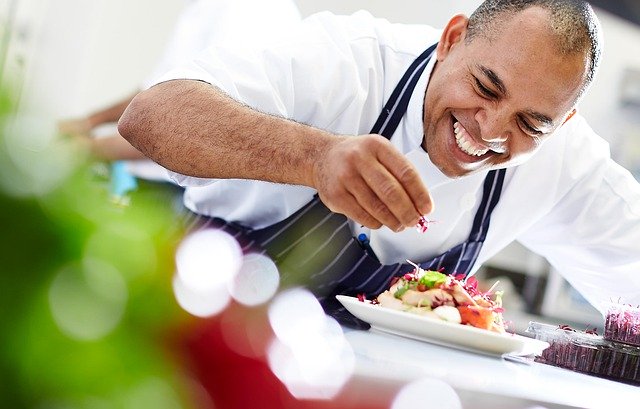
 Food not only sustains us, but nourishes our senses of identity, heritage, and nostalgia. Here journalist and instructor Naomi Tomky tackles some common questions about getting started and also thriving as a food writer.
Food not only sustains us, but nourishes our senses of identity, heritage, and nostalgia. Here journalist and instructor Naomi Tomky tackles some common questions about getting started and also thriving as a food writer.
Tomky writes for publications including Food & Wine, The New York Times, Saveur and Travel + Leisure. She was included in the 2017 edition of Best Food Writing and has won a 2019 Lowell Thomas and an Association of Food Journalists Best Food and Travel Award, and contributed to numerous cookbooks and guidebooks. Her own, The Pacific Northwest Seafood Cookbook, came out in November 2019. She teaches Focus on Food Writing for us, alongside Kae Lani Palmisano.
Q: Do I need credentials to be a food writer?
Absolutely not! The best way to pitch yourself is to pitch a good story and do so well. Show off your writing skills with an excellent pitch that makes it easy for an editor to say “yes.” Typically, that’s not just a well-presented strong idea, but one with a case for why it works for that magazine. Cold pitching can be scary, but it launched my career (Serious Eats), got me my biggest byline (The New York Times), and has powered me throughout my career.
That said, when I’m pitching “myself” as opposed to a specific piece, I try to focus on what makes me stand out. I have a long-running joke that I tell travel editors I’m a food writer and food editors that I’m a travel writer, but it’s real. If travel editors talk to 1,000 travel writers that week, and I introduce myself as a food writer, I’m going to stick out when they want a culinary story. If you have a niche expertise or an area of interest, explain that, give them something to connect you with in their brain, that you can refer back to in the future.
(Editor’s note: Tomky founded the site Successful Pitches, which helps demystify the mysterious art and complicated science of writing query letters. The Columbia Journalism Review featured this awesome free tool in 2020!)
Q: Do I have to review restaurants?
Far less of food writing is restaurant-focused than most people envision! Even Eater, which once drew a hard line, has expanded its scope during the pandemic.
 Food—love it or hate it, revere it, or consider it mere fuel—is a part of our everyday life. We eat multiple times each day, no matter what we think about it. We eat with people, we eat foods we love, we avoid certain foods because of our beliefs or personal tastes. Behind each meal—whether we stop to think about it or not—is the person who prepared it, the person who grew or raised the ingredients, the person who invented that dish, and so many more who had a hand on getting your food to you in the form that it is.
Food—love it or hate it, revere it, or consider it mere fuel—is a part of our everyday life. We eat multiple times each day, no matter what we think about it. We eat with people, we eat foods we love, we avoid certain foods because of our beliefs or personal tastes. Behind each meal—whether we stop to think about it or not—is the person who prepared it, the person who grew or raised the ingredients, the person who invented that dish, and so many more who had a hand on getting your food to you in the form that it is.
Food writing can touch on any of these just tangentially, or it can focus squarely on what is on the plate in front of you. Truly few limits govern what the term “food writing” can entail!
To call out a few notables:
- Humor—I Made the Pizza Cinnamon Rolls from Mario Batali’s Sexual Misconduct Apology Letter by Geraldine DeRuiter (who also recently went viral bagging on a Michelin-starred restaurant, which responded with Dadaist pictures of horses)
- News—our alumna Jessica Eng crushed it with Vegan barbecue is carving out a place in traditional meat-smoking regionsin The Washington Post
- Memoir—What Happens When a Brown Chef Cooks White Food by Khushbu Shah and The Thanksgiving Tale is a Harmful Lie by Sean Sherman
- Profiles— Mayukh Sen’s She Was a Soul Food Sensation. Then, 19 Years Ago, She Disappeared is pretty much a master class of the subgenre.
- Recipe Writing: Andrea Nguyen’s recipes are the pinnacle of the art. They engage and inform in the headnotes, explain the reasoning behind each choice and action, then walk the reader through each step with multiple ways to check if you are on track for success. Her crab cake banh mi recipe is a great example.
Q: I feel lost in the fray when submission calls drop on social media or in newsletters, etc. How else can I find new markets?
One: read everything! Devour newsletters from experts that might lead you to new writers or outlets, scan Twitter and Instagram for what people are looking at, and examine media news to see who is hiring A-list talent.
Two: As you’re reading, look at the names of people whose writing you admire or who write on a similar topic. Then scan their portfolios or subscribe to their newsletters or social media feeds.
Three: Take risks and force yourself to seek new outlets, even if that’s only for 15 or 30 minutes each week. We’re creatures of habit, but if you’re not moving forward and exploring new outlets in this industry, you’ll stagnate.
And finally, check out Write Like a Honey Badger’s compendium on resources that help you discover new markets!
Q: Is it ever okay for a food writer to recycle story ideas?
This is one of the keys to making more money as a journalist! It’s all about breaking it down into bite-size pieces of any type. Can you perhaps do a profile on a character involved, a local-interest piece on a small scale, a time-tied piece to a big event or upcoming holiday, and/or a national piece that angles it to a wide audience? Then you’re repurposing background research and really cooking with gas!
To get started, try using the same 5 “w” questions you might remember from high school English. For example, say that as a food writer, I knew a cool new potato was coming to market (a la the Cosmic Crisp Apple). I could break it down like this:
- Who? A profile type story on who developed it — this could go to a local paper in their town or a college alumni mag.
- What? Potatoes are produce, so maybe The Packer, a trade magazine about produce, wants a story on this.
- Where? If it’s hitting a favorite store like Costco or Trader Joe’s, The Kitchn might be interested. If you can only get it through a fancy direct-to-consumer app, there might be a Wired story there.
- When? Can you time-tie it to an upcoming holiday for a recipe story — why the New Potato will improve your Thanksgiving mashers.
- Why? Why does this potato matter to whatever audience of a magazine (Parents, Bostonians, vegans, horse fanciers, whatever!)
Q: I know timely angles often help writers break into new markets and land choice assignments. But they’re my bête noire! Any tips to ease the pain?
We go in-depth on this topic in class, but here are a few quick tips to get you started. Ask yourself: what change is happening to a product, person, trend, or technique? Who is using it? Who was using it before? Who invented it, moved it around the world, popularized it?
 Then consider why this is happening. Follow the money: Who is making money from this, where did it come from, when did it come, how was it spent? Do the changes have to do with geo-political developments or migrations, technological advances, or cultural shifts?
Then consider why this is happening. Follow the money: Who is making money from this, where did it come from, when did it come, how was it spent? Do the changes have to do with geo-political developments or migrations, technological advances, or cultural shifts?
Once you nail down what’s changing and why, you have likely led yourself directly to why it matters: what this leaves behind in the past, says about humanity, or brings in the future.
Q: How can I find fresh stories to tell when the pandemic has limited in-person reporting for almost two years now?
Trying something new is easy when you can’t go to your favorite restaurant because you’re in a different place. When travel is limited, look for ways to mentally transport yourself. Spend a day in a new neighborhood or nearby town, and research it the same way you might for a travel piece. Ask locals what they like, read local papers or blogs, dig into the history. Don’t just eat a meal there, but get to know it the way you might a small town in Mexico or the wine styles of Portugal, or wherever you’d normally explore.
People often talk about “traveling through food,” but it’s not just about eating a cuisine from elsewhere. It’s about finding the story—the narrative—behind a place. If you’re going to a suburb 20 minutes away to write about a Malaysian restaurant, it’s not just about whether the food is good, but what was the owner’s journey? Open that up: how did they end up in that place and what decisions did they make about which dishes to put on the menu? Where has the food been before it gets to the restaurant? Are they importing specific ingredients that aren’t common in the area, or is somebody growing or making them nearby? How does the food connect where they are to where they’ve been and where they’re going?
Q: The food writing community is having a moment of reckoning about representation—especially regarding who should cover stories about cultural heritage. Can you discuss some best practices?
Recognizing ethical discussions like this are a necessary part of food writing is step one, so that’s good. Next, you need to assess if you will be doing a disservice not only to the piece and audience by not bringing a specific point of view, but also to any groups of people.

In the class, I remind students that a food did not miraculously appear: it was cooked, developed, produced from ingredients, which were grown and harvested. And where that happened and who did that all have meaning—and recognizing or ignoring who and where has real life consequences. As my co-teacher Kae Lani Palmisano points out: “Reporting on food is an opportunity to rewrite the history that has erased the outstanding work of marginalized communities and give credit where credit is due.”
You need to be aware of what you do know, and recognize what you don’t know or can’t know.
That doesn’t mean you should never write about a cuisine you aren’t an expert on, though! For example, Soleil Ho talks about writing about a less-familiar cuisine in this review. But the key is knowing where that line exists.
It can really help to brainstorm with good friends in the industry. Some decisions will be obvious, others will be harder. If you’re unsure whether you can bring the full weight and spectrum of what needs to be said through interviews and sourcing, you need to let someone better able to do that take over.
Naomi Tomky and Kae Lani Palmisano teach Focus on Food Writing several times a year.
